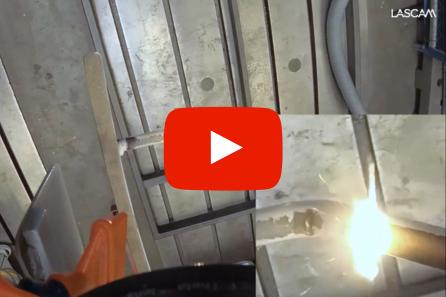Currently, laser technologies are used in a variety of industrial plants, and among the places they can be easily installed are paint shops. The laser cleaning of suspension technology using a pulsed laser integrated directly into the painting process is a good example of a successfully completed project. We developed and supplied this to our customer, a manufacturer of plastic parts for the automotive industry.
Eco-friendly laser cleaning of jiggs in the paint shop
How does laser cleaning of jiggs work?
When painting products, the suspension technology on which the part is fixed is subjected to repeated sprays of paint, the build-up of which gradually affects the accuracy of the seating surfaces of the separate suspension parts, thus affecting the quality of the painting. With some types of paints, older coatings may even accidentally delaminate (fall off); they get stuck to the newly painted surface and thus NOK pieces are produced.
Laser cleaning is carried out by means of a pulsed laser of exceptionally high power (multiple kW), which removes coating layers with high accuracy without impacting the deeper material structures. The process is very precise and therefore there is no need to mask untreated parts. Individual coats of paint, unlike the base material, absorb the focused laser beam well, causing them to heat and subsequently evaporate from the base material.
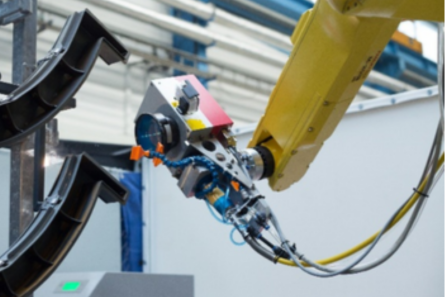

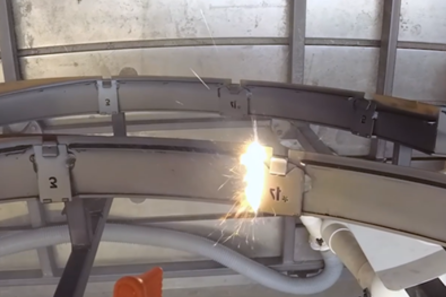
Automatic cleaning with an in-line integration option
Our proposed solution is designed as a stationary device with optional in-line integration into the process. Therefore, in the case of cleaning critical points on suspension technology, we are able to include the laser cleaning of suspension parts directly in the process line for each painting cycle, without any need for a bypass. This eliminates the previous need to transport suspension parts for cleaning to an external facility, which in itself significantly saves costs. In addition, laser cleaning is now much more environmentally friendly compared to previously used methods, such as pyrolysis or dry cleaning.
The workstation is equipped with a 6-axis robotic arm that carries a laser head. During cleaning, the suspension is mounted on a vertical carousel with rotary units, which positions it at the best angle for the robot arm. The advantage of the solution also consists in the uniform direction of residue extraction from the process, which with subsequent high-pressure blowing ensures that the cleaned suspension is maximally free of all paint residues. Thanks to the optimisation of the robot’s crossing paths, a significant reduction in the total time of one cycle has been achieved.
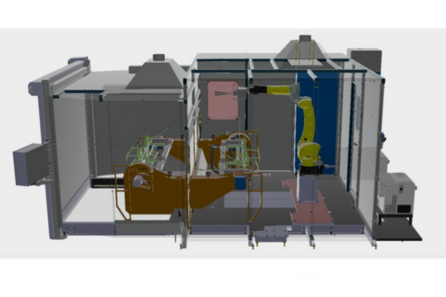
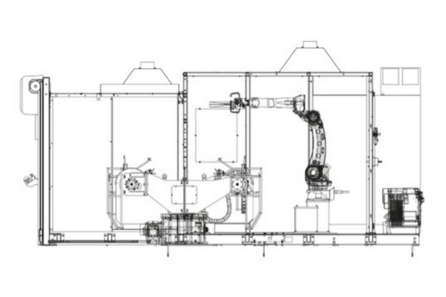
Main benefits
By successfully installing the laser cleaning system for suspension technology, we have helped a customer to achieve considerable energy savings and enabled them to save money on the consumables previously needed for former technologies (pyrolysis and dry cleaning). At the same time, cleaning one set of suspension parts has been accelerated, and is now completed in a quarter of the original time. Also, due to the low level of heat introduced during laser cleaning, the shape of the suspension remains stable and therefore no subsequent calibration is required. The process is also much more environmentally friendly, and by rapidly reducing the carbon footprint, the customer will approach the required CO2 neutrality for production.
Features and benefits of the solution:
- Reduction in the energy costs of the cleaning process by 45 % from 150 kW/h to 19 kW/h per set of suspension.
- Elimination of the problematic pyrolysis process
- Cleaning the suspension set only takes 25 % of the original process time.
- Extending the service life of suspension technology due to the low heat input during cleaning – no subsequent calibration is required.
- Cleaning speed for 300 μm of paint at 1,300 mm²/s, without any need for additional consumables

